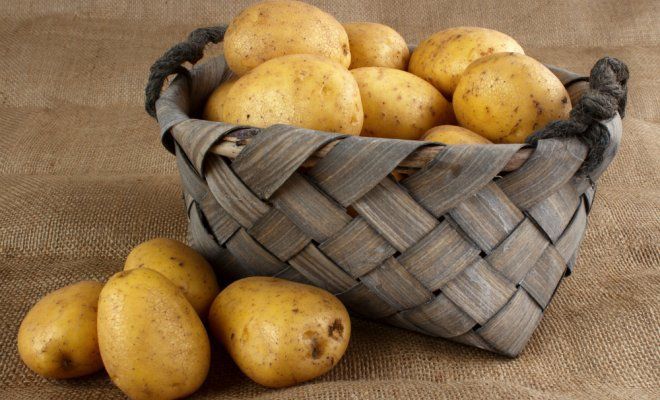 It is believed that Gala potato belongs to the group of early maturing species. Rapid growth has attracted many garden enthusiasts. Harvesting is possible after 2-3 months (on average after 75 days) from the moment of planting.
It is believed that Gala potato belongs to the group of early maturing species. Rapid growth has attracted many garden enthusiasts. Harvesting is possible after 2-3 months (on average after 75 days) from the moment of planting.
This variety is resistant to most diseases, unpretentious to the soil and can grow in various regions. On average, up to 25 potatoes can be harvested from the bush with proper care.
Content
Description and characteristics of potatoes Gala
Outwardly, you will see a medium-tall bush. Semi-upright or sprawling variant of the plant and the intermediate type. The medium-sized leaves are usually dark green, have uneven edges, help the plant easily adapt to hot conditions. Corolla in whitish flowers.
Fruits: The tubers are also medium in size. By weight, approximately 100-150g one tuber. They are oval or round in shape. Yellowish color (skin, middle). The eyes are small located close to the surface. Young potatoes are easy to peel, which is also a plus. After removing the peels do not darken.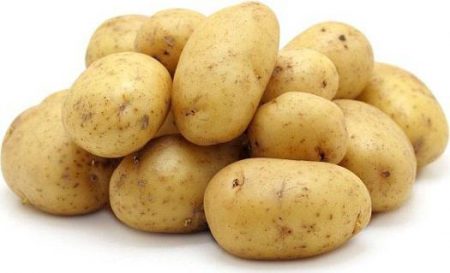
Nutrient, contain 14% starch, but it is also rich in carotene. The composition also includes up to 3.5% protein, vitamin C up to 12 mg per 100 g of potatoes. Taste is rated at 9/10. Therefore, this type of potato is often used in cooking for children.
Has a good mark for presentation - the indicator is 94%. It tolerates transportation well and does not lose sight.
Features of growing potatoes Gala
Soil preparation
This potato variety is not very whimsical to the composition of the soil and adapts to almost any type of land. However, in heavy soil it is difficult for young tubers to grow. Therefore, potatoes in one hole are small, but larger than usual. If the soil is heavy, then the fruits are deformed, their appearance deteriorates, and the amount of waste increases during cleaning. Therefore, if you know that on your site heavy soil before planting, you need to dilute the soil by applying river sand in combination with humus.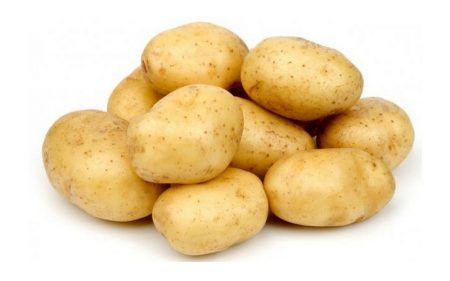
The best time for fertilizing the earth is autumn. At this time, you can use any type of organic dressing - manure, compost, humus. Before the onset of spring, the lure will be processed in the ground by the planting period.
Maybe you need to fertilize in the spring, in which case you do not need to use fresh manure. Fertilizers are applied per 1 square meter on average 6 kg (5 - 8 kg depending on the soil) of the organic composition. With a lack of compost, it can be compensated later. In this case, during the planting of potatoes, a small amount of compost and one large spoon of wood ash are poured into each hole.
Seed preparation
As a planting material, medium-sized potatoes are selected. Since small nutrients are not enough, and they will not be able to give the proper nutrition to the roots, and therefore to the plant itself. Tubers with thick sprouts about 1 cm long, slightly green and with strong skin are perfect for planting. Sowing potatoes are temporarily left in the light, but at the same time they try to prevent direct sunlight from falling.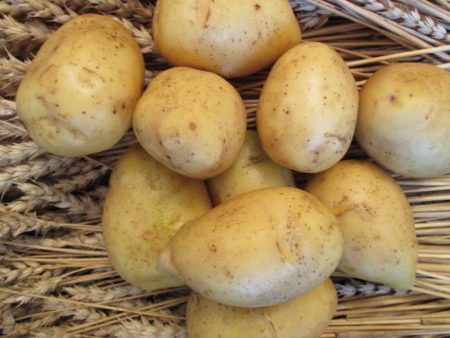
Landing Features
Tubers need to be planted in warm land. It is necessary that it warms up to 10 ° C. This is the best variant. In cold land, tubers can rot.It is necessary to adhere to the recommended planting patterns - do not plant several tubers close to each other or in the same pit. If you do not follow the recommendations and plant closely, the fruits will be small and crooked.
The ground before planting needs to be dug to a depth of 40cm. It also helps get rid of the Colorado potato beetle. You can cultivate the earth with ammonia water.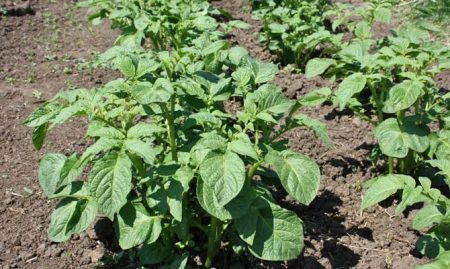
Landing options depending on soil and climate:
- In areas where moist loamy lands predominate, crests are created for planting potatoes, planting material is immersed for 6-10 centimeters.
- Sandy and sandy soils in dry and arid areas need a smooth landing. Potatoes in this case are sprinkled with earth for ten centimeters.
- In lowlands and heavy soils, where high groundwater, potatoes are planted on ridges. This protects it from excess moisture. Such soil must be diluted with sand and loosened so that the tubers do not suffer from a lack of oxygen.
How to Care for Potatoes Gala
Fertilizers
| Development stage | How much to fertilize (per 10 liters of water) |
| One month after landing |
0, 5 l of liquid droppings or dry mullein; 1 spoon of urea |
| At the stage of bud formation |
3 tablespoons of ash, 1 spoon of potassium sulfate; 1 glass of wood ash |
| During flowering |
1 cup of cow or bird droppings; 2 tablespoons of superphosphate |
Watering
Potatoes are irrigated three times a season. But you also need to consider the amount and frequency of precipitation. Watered in the morning or evening so that the sun does not burn the plants. The bush normally requires about 3 liters of water. If the summer is dry and hot, then you need to water every 4-5 days. This variety is difficult to respond to excess moisture, is well resistant to arid conditions.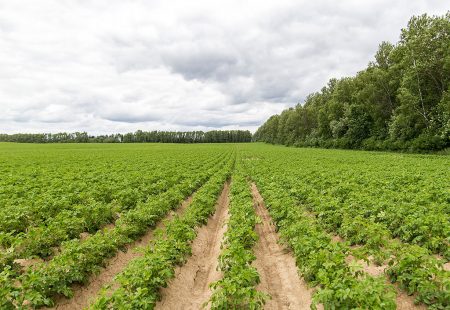
Hilling and cultivating
Potato roots need an influx of fresh air, for this purpose, from all sides near the bush, the soil is loosened 5 days after planting. Then this procedure is repeated as the crust appears. To protect plants from temperature extremes, they carry out hilling. Most of all, this method is relevant in areas of the northern and middle strip, in which the minus temperature can return until the beginning of summer.
First, the hilling is carried out when the sprouts are 10 cm in height, then when the growth of the plant is 40 centimeters. Around the bush create an earthen hill. It needs to be done
In the early morning or evening hours, after watering, when the sun does not greatly fry. It is impossible to carry out hilling in the afternoon, tubers under hot soil overheat and deteriorate.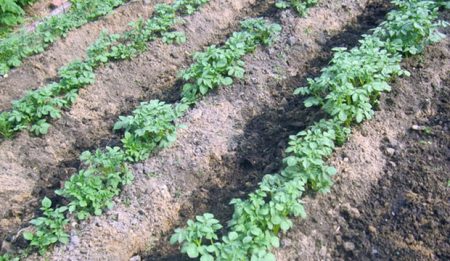
Diseases and pests and methods of dealing with them
This potato variety is able to be stored, and has resistance to certain diseases, such as a nematode. But the species is susceptible to the following pathogens:
- Leaf twisting virus;
- Rhizoctonia is a disease of a fungal nature, manifested from the bottom of the stem.
- Tuberous blight. More common late blight.
Most often, this variety is affected precisely by rhizoctonia. It is also called the "favorite pathogen." When a fungus is affected, all parts of the plant suffer - from the roots to the leaves. On tubers, the disease looks like dark, very dense lumps, and on sprouts these are brownish sores. As it grows, the fungus destroys the plant sprouts.
The diseased plant withers, and its development is delayed. Most often, infection occurs through the ground, and diseased tubers can also be in the role of the carrier of the disease. Rhizoctonia, when it is launched, can reduce the yield by a quarter. In order for the plants to be healthy, you need to follow these recommendations:
- When landing, make sure that the earth has warmed up;
- There should be no crust on the ground;
- Before planting, you need to process the potatoes with a 1.5% solution of borax or boric acid;
- Spray seedlings for disease prevention with “Zircon” (at the rate of 0.3 ml per ten liters of water).
If you notice that the potato is sick, you need to treat it with Kuproksat fungicide at a dosage of 25-50 grams per bucket of water. After 10 days, you need to repeat the treatment. You also need to remember that chemicals do not need to be consumed a month before the harvest.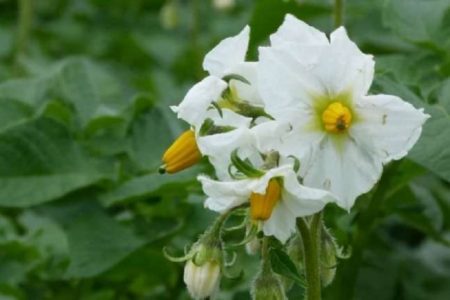
Harvesting
Waiting for the result, planting a variety of Gala, does not take long. Its maturation occurs within 70-80 days. In warm climatic regions (southern and central stripes) you can collect several crops per season. In cold latitudes, such a feature of this variety as early ripening allows you to harvest potatoes by the beginning of the rains. The yield of one bush is 25 tubers.
Two weeks before harvesting, it is necessary to remove the tops, this will increase the preservation of root crops. Potatoes will not lose their appearance and preserve nutrients. The fruits are covered with a strong peel, so they are well experienced in transportation.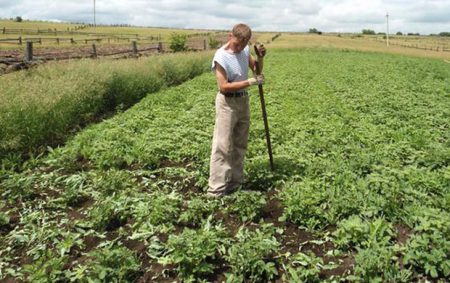
Harvested potatoes for the next sowing, before storage, can be treated with Bactofit (calculated as 30 ml per 10 l of water, kept in solution for fifteen minutes) or Maxim (4 ml in 2 l of water). This will prevent spoilage and the possibility of infection.
Keep potatoes in ventilated boxes, drawers or sprinkled. Tubers can be stored at 0-7 degrees, but 0-2 ° C is ideal. Harvested leaves in the back room, shed or balcony. If the temperature is minus, then you need to wrap potatoes so that it does not freeze. For this purpose, you can use the old warm clothes.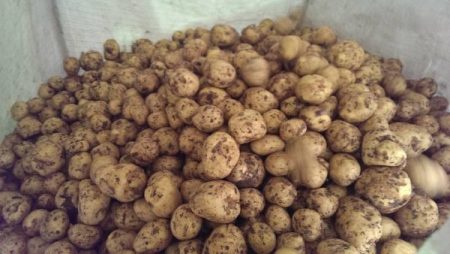
After harvesting, the potatoes must be sorted - selected damaged, for sowing and, of course, for food. Allow to lie down a bit and put into storage.
Reviews
Valery: I have a small plot, so I liked that this variety of potatoes is not sprawling and does not take up much space. Bushes stretch up. Plus - it quickly matures, about 2 months. Externally, the potato is beautiful. Tiny eyes, almost invisible. The potato is oval, well-tolerated transportation. It is convenient to wash and clean, it is pleasant to cook. It does not boil.
Anna: I have been planting this variety for five years, positively affected. Gala seemed tasty to me, pleased with its high productivity. I advise everyone to grow this variety.
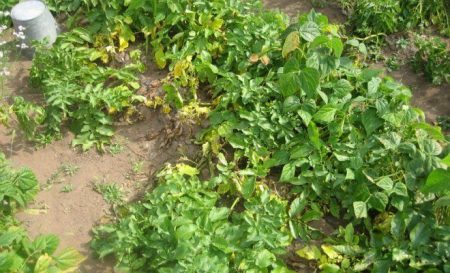
Sergey: My wife and I once decided to choose potatoes for planting at random, so it happened that we bought the Gala variety. Quickly ripened, also wanted a yellow look. It seems to me tastier. I liked that when cooking it did not fall apart, when frying it turns out perfectly.




 Description and description of varieties in Belarus with a photo
Description and description of varieties in Belarus with a photo Do I need to pick flowers from potatoes: why do they do it
Do I need to pick flowers from potatoes: why do they do it When to dig potatoes: timing and availability of new potatoes
When to dig potatoes: timing and availability of new potatoes How to grow a good potato crop: various methods and methods, planting and care
How to grow a good potato crop: various methods and methods, planting and care